North Shore Greenhead Fly Program
 In the early sixties, public demand for relief from the nuisance of greenhead flies resulted in the organization of the North Shore Greenhead Fly Program. The project developed an environmentally friendly method of controlling greenheads. Several years of research led to the development of the greenhead fly trap. The project became routine operation of annual deployment, retrieval and maintenance of traps. The operation continues today with the exceptions of the development of Octenol as an attractant which is now used in the traps.
In the early sixties, public demand for relief from the nuisance of greenhead flies resulted in the organization of the North Shore Greenhead Fly Program. The project developed an environmentally friendly method of controlling greenheads. Several years of research led to the development of the greenhead fly trap. The project became routine operation of annual deployment, retrieval and maintenance of traps. The operation continues today with the exceptions of the development of Octenol as an attractant which is now used in the traps.
The Greenhead fly (Tabanus nigrovittatus) is a species of biting horse fly commonly found around coastal salt marshes of the Eastern United States. The biting females are seen as an excessive pest to humans and animals, seeking out a blood meal in daylight hours, attacking persistently. These flies have a short life span, appearing in early July, and extending through August. Greenheads are not life threatening but they are a huge nuisance and threat to tourism. They are fairly resistant to pesticides; in return the district sets over 400 traps out over eight towns in June, along the creeks of the salt marsh, to prepare for the invasion of the Greenhead fly. These traps are 4 foot tall black boxes with legs, giving a silhouette appearance of a grazing animal. This entices the flies to bite the underbelly of the trap, which has a small opening for the flies to go into and get stuck inside the box. Single traps can capture hundreds of flies per day, preventing further reproduction, creating a huge reduction in greenhead overall annoyance. The trap is simple, yet highly effective. Traps are set by walking out to the marsh or by boat along the creeks. Location of the traps are key, trap location is subject to change based on the district’s research and historical data for said salt marsh.

Octenol is short for 1-Octen-3-ol and also known as mushroom alcohol or ox breath. It is a chemical that attracts biting insects such as mosquitoes and greenhead flies. It is contained in ox breath, human breath and sweat. Octenol is used, sometimes in combination with carbon dioxide, to attract insects in order to kill them with certain electronic devices. Its odor has been described as moldy, meaty or vaguely similar to anise or licorice.
Greenhead Fly Frequently Asked Questions
What is a “Greenhead Fly”?
The Greenhead flies of Essex County, MA are insects that are called horseflies. They belong to a family called Tabanidae. The name comes from the large iridescent compound eyes which appear as dark green.
Why are Greenheads a problem?
Because they occur in great numbers, the females bite during daylight, they can fly for miles, attack persistently domestic animals and people, and they interfere with the enjoyment of coastal areas throughout much of the summer.
Why do Greenheads bite people and animals?
Only the females are equipped to pierce the skin to take a blood meal. They seek out a blood meal to provide a rich protein source necessary for egg development. Protein for the first egg mass is obtained when the predaceous larva eats other insect larvae or small animals.
What are some of the things a person can do to reduce fly nuisance?
- Biting flies prefer dark over light objects. Wear appropriate apparel with this in mind
- Dry off after being in water
- Wear long sleeved shirt for protection
- Timing – female flies are most active from 10:00am to dusk.
- Screen in pools, porches, patios, etc.
- Keep windows on cars closed. If some flies enter, brush them out – do not take a chance, the distraction could cause you an accident.
- Remember – sprays, perfumes, and increased metabolic activity serve to attract the biting female.
Where do Greenheads come from?
Greenhead flies are produced from our coastal marshes. Early settlers of the area reported their problem with biting insects and had to protect their stock. Adult flies mate on the open marsh. Within a few days without seeking a blood meal, the female lays her first (of up to four) egg mass consisting of 100 to 200 eggs on marsh grass.
The eggs hatch into worm-like larva, with as many as 80 larvae in a single square meter of marsh sod at maturity. Developing larva concentrate along the upper vegetation zone reached by daily high tides. The larvae forage around surface muck, through wet thatch and vegetation. The predaceous larva attack and devour a variety of invertebrates, including some of their own kind. The larvae overwinter beneath the frost, form a pupa in early summer, forage around briefly (10 days or so) and then depending on environmental conditions emerge into adult fliers.
Are Greenheads harmful?
As a nuisance and economically, greenhead flies can be very harmful. In Essex County they affect real estate values, beach use, golfing, outdoor recreation, and so on. They are not considered a health problem to people as they have not been found to transmit disease. However, some people have strong allergic reactions to their bite.
When are Greenheads at the highest volume?
It varies – generally the farther south, the earlier the “peak” of activity occurs, e.g. Saugus, Manchester. The environmental conditions dictate the emergence and development e.g. tides, light, temperature. The season is from June to September with the highest densities occurring the last two weeks of July to the first week of August.
How can Greenheads be controlled?
Because of their predaceous nature as larva a significant reduction in number could produce a trade-off in species produced. For example, if greenheads did not keep the deerflies in check that problem could possibly become greater. Conventional methods of biting fly control are either environmentally undesirable or economically impractical. Because of the large size of the larva and adult it would take a higher concentration of fairly toxic pesticides to control them and thus adversely affect other non-target organisms. Burning the marshes, water management, ditching or impoundments have been found ineffective and costly. Therefore at this time the most environmentally and economically solution to the greenhead fly problem is the proper trapping on the salt marsh.
How does the North Shore Greenhead Fly Project Control the flies?
For a number of years our research and development has been directed toward abatement of nuisance levels along beaches, recreational areas, and housing. In 1968 we began developing a box trap which has been modified many times and will probably be subject to other changes from year to year as we attempt to increase its effectiveness. In fact, traps capture large numbers of blood seeking flies, and if such traps are located on the marsh may serve as a control for greenheads. Each year we place over 460 traps on the marshes of coastal towns and gather and remove millions of biting flies from circulation.
